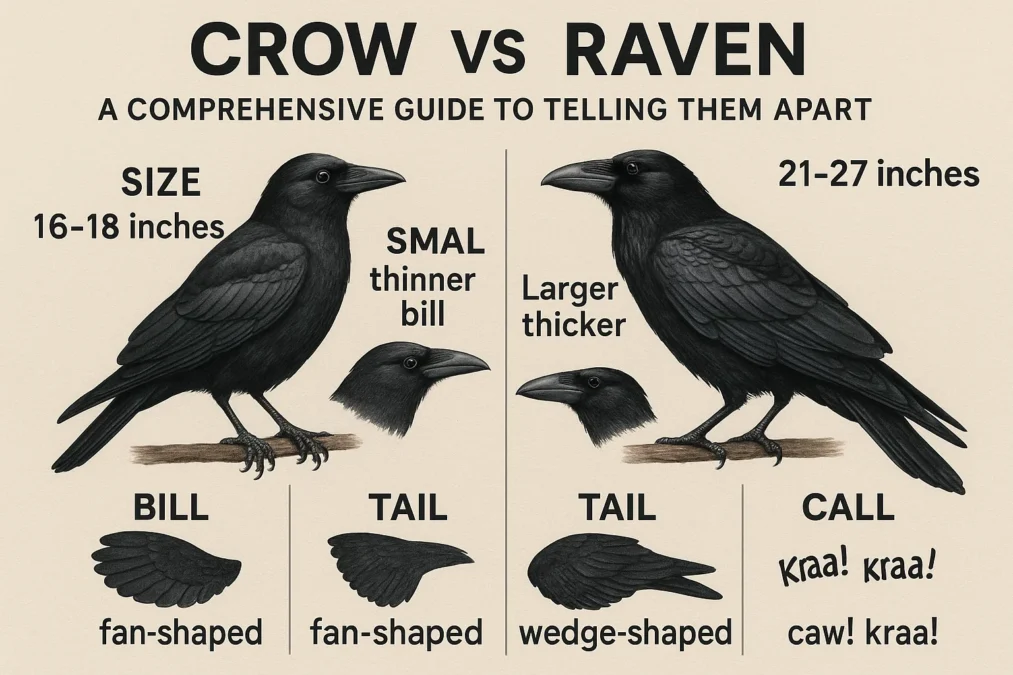Crow vs Raven: When it comes to corvids, crows and ravens are often confused due to their similar black plumage and intelligent behavior. However, these birds are distinct in many ways, from their physical characteristics to their behaviors and habitats. Whether you’re a bird enthusiast or just curious about these fascinating creatures, this guide will help you confidently tell crows and ravens apart.
Physical Differences: Crow vs Raven
Size Comparison
One of the most noticeable differences between crows and ravens is their size. Ravens are significantly larger than crows, measuring up to 27 inches in length with a wingspan of around 54 inches. In contrast, crows are smaller, typically about 16-21 inches long, with a wingspan of 32-40 inches.
If you see a large black bird soaring overhead, it’s likely a raven. Crows, on the other hand, appear more compact and agile. However, size alone can be misleading if you don’t have a direct comparison, so it’s essential to look for other distinguishing features.
Beak Shape and Size
The beak is another key feature that sets these two birds apart. Ravens have a thicker, more curved beak, often described as “hefty” or “robust.” This powerful beak is adapted for tearing into carrion and other tough food sources. Crows, meanwhile, have a straighter and more slender beak, which is better suited for their omnivorous diet.
When observing these birds, pay attention to the beak’s shape and size. A raven’s beak is a clear indicator of its identity, especially when viewed up close.
Tail Shape
The shape of the tail is a reliable way to distinguish crows from ravens, especially in flight. Ravens have wedge-shaped tails, which appear pointed when spread open. Crows, on the other hand, have fan-shaped tails with a more rounded edge.
Next time you spot a black bird flying overhead, take a moment to observe its tail. A wedge-shaped tail is a telltale sign of a raven, while a fan-shaped tail indicates a crow.
Behavioral Differences: Crow vs Raven
Vocalizations
Crows and ravens have distinct calls that can help you identify them. Crows are known for their loud, sharp “caw-caw” sound, which is often heard in urban areas. Ravens, however, produce a deeper, more guttural croak, often described as a “gronk” or “kraa.”
Ravens also have a more complex vocal range, including melodic knocking sounds and even mimicry. If you hear a bird imitating other sounds or producing a variety of calls, it’s likely a raven.
Flight Patterns
The way these birds fly can also help you tell them apart. Ravens are masters of soaring, often gliding effortlessly on air currents with minimal flapping. Their flight is smooth and majestic, resembling that of a hawk or eagle.
Crows, in contrast, rely more on flapping their wings and have a quicker, more erratic flight pattern. They are agile flyers, capable of rapid turns and maneuvers. If you see a black bird performing acrobatic feats in the air, it’s probably a crow.
Social Behavior
Crows are highly social birds, often seen in large flocks, especially during the winter months. They are known for their communal roosts, where hundreds or even thousands of crows gather at night.
Ravens, on the other hand, are more solitary or found in pairs. While they may gather in small groups around food sources, they don’t form large flocks like crows. This difference in social behavior is a key clue when identifying these birds.
Habitat and Geographic Range
Common Habitats for Crows
Crows are highly adaptable and thrive in a variety of environments, including urban areas, farmlands, and forests. They are often seen in parks, backyards, and city streets, where they scavenge for food and interact with humans.
Common Habitats for Ravens
Ravens prefer more remote and rugged habitats, such as mountains, cliffs, and deserts. They are less common in urban areas, although they can occasionally be spotted in rural outskirts or near large open spaces.
Geographic Range Overlap
While crows and ravens have overlapping ranges in some regions, their preferred habitats often keep them apart. In areas where both species are present, paying attention to their behavior and physical features can help you distinguish between them.
Myths and Cultural Significance
Crows in Folklore
Crows have long been associated with mystery and intelligence in folklore. In many cultures, they are seen as omens or messengers between the living and the spirit world. Their cleverness and adaptability have earned them a place in countless myths and stories.
Ravens in Mythology
Ravens hold a special place in mythology, often symbolizing wisdom, prophecy, and transformation. In Norse mythology, Odin, the god of wisdom, had two ravens, Huginn and Muninn, who served as his eyes and ears in the world. Ravens are also prominent in Native American legends, where they are revered as creators and tricksters.
How to Identify a Crow and a Raven by Their Nests
Crow Nests
Crows build smaller, more compact nests, often located in trees or on building ledges. They use a variety of materials, including twigs, grass, and soft lining, to create a cozy nest for their young.
Raven Nests
Ravens construct larger, bulkier nests, typically placed on cliffs or tall trees. Their nests are made of sticks and lined with softer materials, providing a sturdy and secure environment for their chicks.
How to Spot Crows and Ravens During Different Seasons
Winter Behavior
In winter, crows form large flocks and gather in communal roosts for warmth and protection. Ravens, however, remain more solitary or in pairs, often foraging in remote areas.
Spring and Summer Behavior
During the breeding season, both crows and ravens become more territorial and focused on raising their young. This is a great time to observe their nesting habits and interactions.
Conclusion
Telling crows and ravens apart may seem challenging at first, but with a little practice, it becomes second nature. By paying attention to their size, beak shape, tail shape, vocalizations, and behavior, you can easily distinguish between these two remarkable birds. Whether you’re exploring urban parks or remote wilderness, keep an eye out for these fascinating corvids and enjoy the beauty they bring to the natural world.
Thunder vs Grizzlies: A Rivalry That Keeps Fans on the Edge
FAQs
Q: What is the main difference between a crow and a raven?
A: The main differences are size, beak shape, and tail shape. Ravens are larger, have thicker beaks, and wedge-shaped tails, while crows are smaller, with straighter beaks and fan-shaped tails.
Q: How can I tell a crow from a raven by their sound?
A: Crows produce a sharp “caw-caw” sound, while ravens have a deeper, croaking call. Ravens also have a more complex vocal range, including melodic knocking sounds.
Q: Where are crows and ravens commonly found?
A: Crows are often found in urban areas, farmlands, and forests, while ravens prefer remote habitats like mountains, cliffs, and deserts.
Q: Do crows and ravens get along?
A: Crows and ravens are known to have a contentious relationship. Crows often mob ravens to protect their nests, while ravens may prey on crow eggs or chicks.
Q: Are crows and ravens intelligent?
A: Yes, both crows and ravens are highly intelligent birds, capable of problem-solving, tool use, and even mimicry.
Key Quotes on Crows vs. Ravens
On Physical Differences:
- On Size: “Ravens are significantly larger than crows… If you see a large black bird soaring overhead, it’s likely a raven. Crows, on the other hand, appear more compact and agile.”
- On Beak Shape: “Ravens have a thicker, more curved beak, often described as ‘hefty’ or ‘robust’… Crows, meanwhile, have a straighter and more slender beak.”
- On Tail Shape: “Ravens have wedge-shaped tails… Crows, on the other hand, have fan-shaped tails.”
On Behavioral Differences:
- On Vocalizations: “Crows are known for their loud, sharp ‘caw-caw’ sound… Ravens, however, produce a deeper, more guttural croak, often described as a ‘gronk’ or ‘kraa.'”
- On Flight Patterns: “Ravens are masters of soaring, often gliding effortlessly… Crows, in contrast, rely more on flapping their wings and have a quicker, more erratic flight pattern.”
- On Social Behavior: “Crows are highly social birds, often seen in large flocks… Ravens, on the other hand, are more solitary or found in pairs.”
On Habitat:
- “Crows are highly adaptable and thrive in a variety of environments, including urban areas, farmlands, and forests.”
- “Ravens prefer more remote and rugged habitats, such as mountains, cliffs, and deserts.”
On Cultural Significance:
- “Ravens hold a special place in mythology, often symbolizing wisdom, prophecy, and transformation.”
Comparison Table: Crow vs. Raven
| Feature | Crow | Raven |
|---|---|---|
| Size | Smaller (16-21 inches long). Wingspan of 32-40 inches. | Larger (up to 27 inches long). Wingspan of ~54 inches. |
| Beak Shape | Straighter, more slender beak. | Thicker, curved, and robust “hefty” beak. |
| Tail Shape | Fan-shaped tail with a rounded edge. | Wedge-shaped or diamond-shaped tail, especially in flight. |
| Vocalization | A sharp, loud, nasal “Caw-caw”. | A deep, guttural, croaking “Gronk” or “Kraa”. |
| Flight Pattern | Constant, rapid flapping. Erratic and agile. | Soars often. Smooth, graceful, hawk-like flight. |
| Social Behavior | Highly social. Forms large flocks and communal roosts. | Solitary or in pairs. Does not form large flocks. |
| Preferred Habitat | Adaptable: Urban areas, suburbs, farmlands, forests. | Remote: Mountains, cliffs, deserts, wild forests. |
| In Flight (Silhouette) | Smaller, with paddle-shaped wings and a rounded tail. | Larger, with longer, pointed wings and a distinct wedge-shaped tail. |
| Group Name | A murder of crows. | An unkindness or conspiracy of ravens. |



